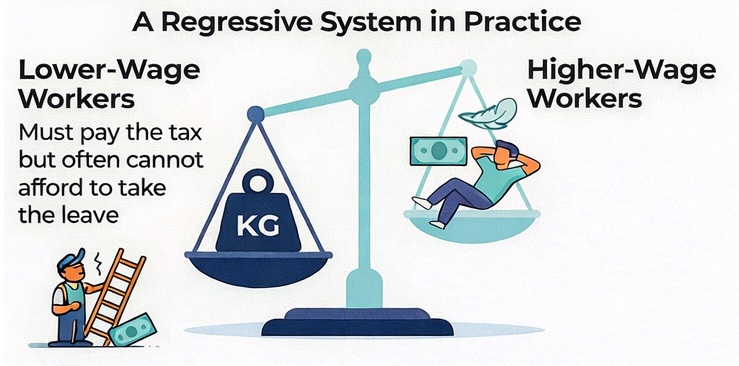Amidst the hoopla surrounding hot-button business issues such as minimum wage, paid sick leave and restrictive scheduling, it is easy to forget there are other issues that have significant impacts on the cost of doing business in Washington State.
One example would be our state-run monopoly workers’ compensation system.
Every employer must have industrial insurance, which covers the medical and time loss expenses of workers who are injured on the job. The problem is employers are forced to purchase this insurance from the state Department of Labor & Industries (L&I). A few of the state’s largest employers have the option to “self-insure,” but that simply means they do not pay workers’ compensation premiums to L&I, they instead cover the costs associated with an injured worker themselves. Washington is one of just four states in the nation with a monopoly system that forbids competition from private insurers.
Under this government-run system that allows no competition, employers have paid increasingly higher workers’ compensation taxes and injured workers have, for years, received the most generous benefits in the nation. Supporters of the government run monopoly (primarily organized labor) paradoxically insist Washington’s state-run workers’ compensation system is “low-cost, high-benefit.” The employers who have shouldered the 69% increase in workers’ compensation rates between 2000-2016 would likely disagree with that characterization.
Nevertheless, to support this impossible claim, supporters of the state-run monopoly system have historically relied on a report from the state of Oregon that has shown Washington’s workers’ compensation costs are lower than many other states.
Last year I testified before the Senate Trade & Economic Development Committee on why the Oregon Consumer & Business Services “Premium Rate Ranking Study” does not provide an accurate measure of Washington’s workers’ compensation system costs and our state’s premium rate ranking. The Oregon study is an apples-to-oranges comparison of Washington’s premium costs to other states. Because of the uniqueness of Washington’s workers’ comp system, a good apples-to-apples system of cost comparison simply does not exist:
- Washington uses unique industry classifications.
- Washington is the only state that calculates workers’ comp premiums based on hours worked, not payroll. This difference in particular makes the Oregon Study an unreliable measure and comparison of our state’s workers’ comp costs. Even the authors of the Oregon study acknowledge the difficulty of comparing Washington’s premium costs with other states because hourly rates have to be converted to payroll rates.
- Washington has nearly three times as many self-insured employers than Oregon, whose costs are not included in the study.
Another problem with the Oregon study are the years in which L&I used contingency reserve funds to buy down, or artificially suppress, the workers’ comp premium rate increase needed to sustain the system. So the rates the Oregon study used those years did not reflect the true cost of our state’s system. Sure, employers did enjoy lower rates as a result of the buy down, but now they are paying more than they should as L&I scrambles to replenish the reserve fund. At the same time, the majority of other states have been steadily decreasing their workers’ comp rates.
Now, after years of touting the Oregon study as evidence that Washington’s system is “low-cost, high-benefit”, supporters of the state-run monopoly find themselves in the uncomfortable position of trying to explain why Washington’s rank in the Oregon study has declined precipitously in recent years, from 38th in 2008 to 15th highest today.
Without gloating too much, this blog posted by the Washington Self Insurers Association perfectly summarizes the discomfit plaguing those supporters.
_______________________________________________________________________________________________________
Washington rises to 15th costliest premium in latest Oregon Study
Oct. 25, 2016
Every two years in October, the Oregon Department of Consumer and Business Services publishes its workers' compensation premium rate rankings. Just last week, the 2016 edition came out. Washington has climbed up to 15th highest premium in the country, according to the Oregon study.
Oregon's rate study is closely followed by the national workers' comp industry, since for most states it is an accurate picture of where pure premium rates rank. Washington, a special snowflake in the workers' comp world, is alone in charging premium by the hour rather than by payroll, and uses unique, rather than standard, industry classifications. A lot of assumptions and conversions have to be made to translate Washington's system into something that can be compared countrywide. Further, as one of the four monopoly states, Washington has a very substantial self-insured community, covering about a third of the workforce, whose claim costs are not accounted for in the study.
Back -- way back -- in the day, in the late 90s and early years of this millennium, Washington used to rank alongside Oregon in the high thirties out of fifty states for highest premiums, prompting the improbable rallying cry at the Department of Labor & Industries of that era, that the secret sauce of Washington's monopoly made us a "high benefits, low cost" state for workers' comp.
Even today you hear vestiges of that mantra echo in labor union leaflets and legislative committee debates, although no employer who has ever paid premiums or underwritten claims costs in Washington has ever thought it was a low cost state.
We don't hear as much about the Oregon Study from the Department or worker advocates as we used to. Starting in 2010, Washington jumped from the 38th highest rated premium to the 26th; and then to the 13th in 2012. In 2014, Washington slid down a few spots to 17, but now in 2016 is back up to 15, holding steady now for three study cycles in the top third for state costs.
The employer community has never been a huge fan of the Oregon rate study, mostly because of the apples to oranges conversions, caveats, and omissions necessary to even rank Washington.
We've tended to watch the annual reports published by the National Academy of Social Insurance (NASI) that track benefit levels and employer costs. As the Washington Research Council points out, NASI data show that Washington expends the highest benefits per covered employee each year of any state in the nation, and has for quite some time.
As the Research Council contends, "benefit costs are the best indicator of the costs of the workers' compensation system and the best way to compare our system to other states."
This is certainly true of our state's self-insured employers, who do not pay premiums but instead pay the benefit costs directly.





